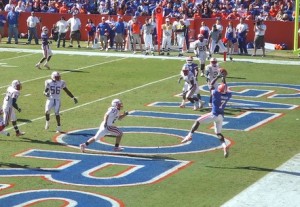Should College Football Be Taxed? Bring Your Questions for Allen Sanderson
 Photo: spakattacks
Photo: spakattacksAllen R. Sanderson is an economist at the University of Chicago who enjoys, among other things, writing about sports. Some of his past work includes pieces on the puzzling economics of sports, why ties should be allowed in baseball, and how football highlights America’s least flattering features.
Sanderson’s most recent piece comes from the November 2011 issue of Chicago Life magazine, entitled “Taxes and Touchdowns.” In it, Sanderson argues in favor of imposing “steep” taxes on college football (and perhaps basketball) and that a college sports tax should be seen as the fifth sin tax, next to taxes on alcohol, cigarettes, gasoline and fat/sugar. And he’s not just talking about taxing certain aspects of college football; he’s talking about taxing the whole shebang: advertising, television broadcasts, logo merchandise sales, gate receipts. And then using that money to help support those “student-athletes” who don’t make it pro in their effort to finish up their education.
With his permission, we are republishing his essay below. Sanderson has also agreed to answer your questions related to this idea. So, read the essay, gather your thoughts, and fire away with questions in the comments section.
Oh, and one more thing: If you’re really into the darker side of college sports, check out this in-depth piece in The Atlantic about the recent flurry of scandals plaguing the NCAA and the idea of paying student athletes.
Taxes and Touchdowns
Leveling the Playing Field in College Athletics
As almost a matter of course, federal and state governments now tax commodities that are broadly deemed “sins.” Tobacco products and alcoholic beverages fall under this heading. The rationale, other than elected officials always grubbing for money, is that consumption of these items imposes, in economics jargon, “negative externalities”; that is, it affects people not party to the transaction and/or imposes costs on society as a whole.
With regard to cigarettes, apart from second-hand smoke concerns and litter, inhaling leads to lung cancer and other diseases, and thus the smoker may make disproportionate use of our health-care resources. (That the smoker pays steep cigarette taxes during his or her lifetime, then tends to die around age 65 without collecting much in the way of Social Security benefits, probably means that smokers are actually paying their own way through life—and death.)
Taxes on alcohol are similar. They are levied to produce revenues that offset domestic violence and help defray the costs of alcohol-related traffic accidents. (There is ample evidence that these taxes are generally set too low to “internalize the externality”—maybe because more politicians drink than smoke?—and thus should be raised.)
Currently, gasoline taxes are the third sin item. Because automobile traffic causes air pollution, contributes to congestion and creates accidents, levies on gasoline serve the same purposes as with tobacco or alcohol. The fourth sin category—fat or sugar—involves our concerns about obesity, and has led some officials and jurisdictions to try to tax fast-food and sugary soft drinks. (That those who are obese have to wear XXL clothing is not an externality; and the jury is still out on whether the heavyset are like smokers and offset part of their societal costs by dying young.)
If these four sin taxes now on the table are acceptable, let me suggest a fifth item: college football games. Yes, I am advocating that we impose steep taxes on all intercollegiate football advertising, television broadcasts, logo merchandise sales and gate receipts.
Why?
About 100 universities will field football teams at the Division I level this year; they will play 12 or more games each, plus from December 2011 through mid January 2012, 70 of these programs will also play in bowl contests. These games generate hundreds of millions of dollars—for the networks, coaches, athletic departments and institutions—but virtually nothing for the young men on the field (except for room, board, tuition, a walking-around allowance and a souvenir t-shirt or cap; and because institutions and the NCAA have gone out of their way to label these players, largely African-American youths from inner-city neighborhoods and modest family circumstances, “student-athletes” not employees, if injured they are not eligible for workman’s compensation and other legal redresses).
Only a small fraction of these thousands of college football players will ever earn a living in the NFL, and less than half of them, in spite of being steered to meaningless “gut” majors and wink-wink instructors, will ever earn a degree from the universities they represent on Saturdays.
Although these athletes are amateurs only under the most twisted definition of the word, some fans, college peers and the general public may arguably have some qualms about paying them salaries. (I do not have any such qualms.) Why that is remains somewhat of a mystery because few seem to object to paying run-of-the-mill coaches $2 million a year in base salary plus generous perks.
Let’s impose a sin tax on the revenues intercollegiate football and basketball generate for everyone but the players. This money could be set aside to provide funding for the ex-players to return to earn a degree, enter a graduate program and/or start a small business.
Fans and universities benefit enormously from this exploitation. It is no stretch to treat this as in the same category as smoking, drinking, gorging ourselves on hot dogs and nachos, most of which we do in the stands or our family rooms while these exploited workers toil for our entertainment and the coach’s yacht. As citizens, we should be above having our entertainment whims sated on the backs of these youngsters. Will it put an end to the cesspools at Ohio State, Oregon, Miami, USC, Auburn, LSU and …? No, but it’s time to draw a halt to the current arrangements.
And for economists, raising the price is generally a good place to start.

Comments